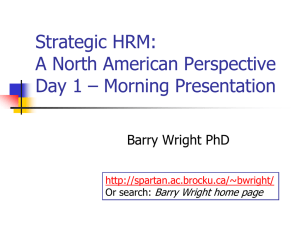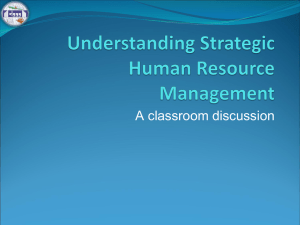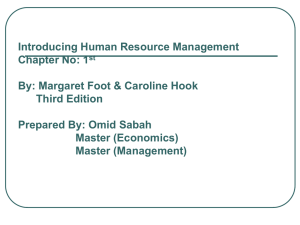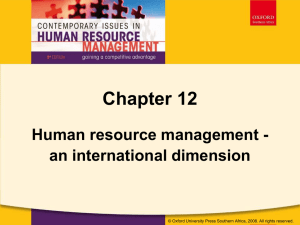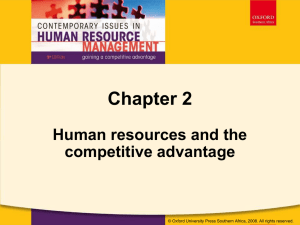The Trouble with HRM - Manchester Industrial Relations Society
advertisement
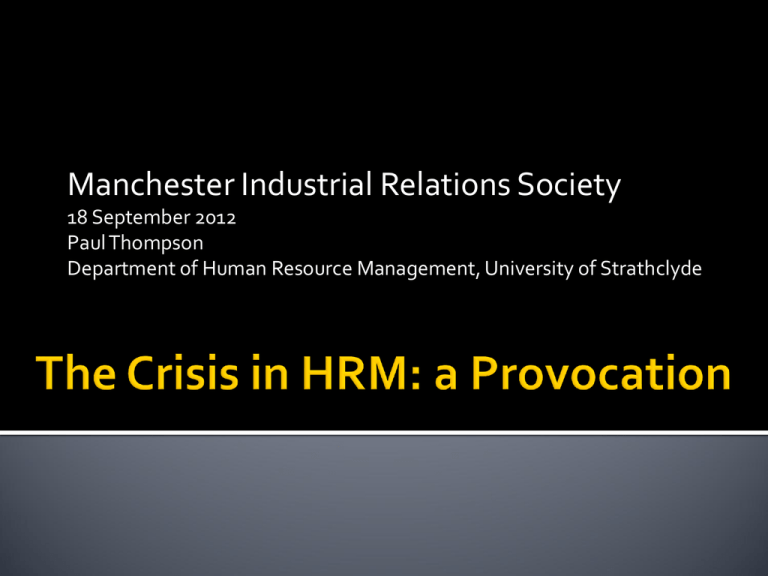
Manchester Industrial Relations Society 18 September 2012 Paul Thompson Department of Human Resource Management, University of Strathclyde ‘For the past decade, research in HRM has focused on the take-up and impact of commitment-seeking “high performance” HR practices that are argued to lead to improved employee and organisational performance’ (Francis and Keegan 2006: 231) ‘The human resource management profession faces a crisis of trust and a loss of legitimacy in the eyes of its major stakeholders. The two-decade effort to develop a new “strategic human resource management” (HR) role in organizations has failed to realize its promised potential of greater status, influence, and achievement’. (Kochan 2006) - confirmed in Guest (2011) paper. The romance of human capital, self-interest of the profession SHRM is fraught with mis-specification…. Is a management-centric theory oriented towards a commitment/ILM type of employment model that gives over-emphasis to psychological factors’ (Kaufman 2010: 16) Revisiting the HRM defining mission and differentiation ‘Soft HRM’ and mutuality models, where commitment and investment in human capital is seen as central to competitive advantage (Appelbaum et al, 2001; Pfeffer 1994, 1998) Universalistic, best practice, commitment model the defining feature of HRM (Guest and others) 239. It replaces the control or compliance model: ‘’create the conditions for employees to display internally self-driven initiative and take more responsibility for monitoring their own behaviour’ (Wood 1995: 216). Link to discretionary effort. Misdirected critique? CMS and the focus on culture, commitment and (soft) HRM as a meaning making machine: ‘founded on the internalization of self-regulation, calculation and control in which externally imposed authority and discipline becomes much less significant’ (Grant et al, 1998: 202). New focus on identity regulation and branding (Alvesson and Willmott (2002) The underpinning human capital narrative: labour as asset not cost, at least to the core rather than contingent workforce (hard HRM) RBV – ‘human capital represents one of the last and best sources of competitive advantage’ (Kaufman 2010) HR tools manage human capital pool. Commitment aligns interests and mobilises discretionary effort A difference between commitment-seeking and commitment generating practices that ‘energise employee commitment’ (Kaufman 2010) ‘There is a danger in treating the normative as a separate category. All control practices have normative dimensions. Even if not explicitly designed to engage with ‘hearts and minds’, their operation and effects will do so’. (Thompson and van den Broek 2010: 6) A difference between high involvment work practices and high commitment employment practices? Pursuit of normative/commitment always over-sold and underresearched. Assumes that the functioning of HRM can be found in its discourse, and those discourses and technologies are largely disconnected from context – lack of interest in the actual effectiveness of the ‘tools’ of HRM Mainstream HRM – going round in circles? ‘In summary, the research is riddle with error both with respect to data on HRM and on outcomes’… ‘requires a complex research methodology and sophisticated statistical analysis ( Guest 2011) The unproven link between high commitment (and other HRM effects) and high performance The empirical critique: minority of firms, minority of practices: emphasis on form not content; but doesn’t tell us much, if anything about commitment Universal models do have a conception of the environment as driver, but it is a weak and impoverished one Economically rational low road choices ‘…it might be argued that, in capital-intensive manufacturing, a HPWS model is preferable as labour costs are a small proportion of total costs and high quality, committed labour can facilitate the optimum exploitation of high-cost plant and materials’ (Legge, 2005b: 229). Cost minimisation /leadership strategies Acceptance of a ‘differentiated workforce’: talent management, targeted investment in human capital, ‘employee of choice’ rather than ‘employer of choice’ (Becker, Huselid and Beatty 2009) Better, but not adequate: external fit based on product market variation; naivety about cost minimisation; ‘competitive pressures’ neglect of capital markets in constructing market discipline High performance does not necessarily protect any firm or group of workers A political economy approach, but which one? Divergent interests and mutual gains in the employment relationship The shift from managerial to financial capitalism, from extraction and realization of value in capital rather than (the management of labour in) product markets The promises of private equity Cost cutting and work intensification Financial intermediaries, owners and local managers: levers and agents, who is making ‘economically rational’ decisions? Disconnected capitalism: impact on local bargains. Divergence of work and employment systems Applebaum and Batt: the turnaround ‘Under the shareholder model of financial capitalism, then, the focus of investment activities shifted – from that of investing in productive enterprises to that of extracting money from companies for further trading activities, which yielded higher returns’ (2010, 7) Organisations are increasingly dominated by the principles of ‘market rationalism’ and normative interventions promoting commitment and focusing on cultural change are becoming less relevant or marginalised (Kunda and Ailon-Souday, 2005; Thompson, 2003). Financialization as a variant of market discipline Can we explain performance outcomes without HCM? Capelli and the ‘frightened worker model’ Old and new forms of insecurity: ‘overall, the results provide reasonably good evidence that employees exert high levels of effort in insecure conditions’ (McGovern et al) Increased emphasis on performance managementdown the chain Weakness of capacity to resist, compliance as a substitute for commitment and trust: to what extent is effort discretionary? Market individualism and the ‘free worker’ So, why HPWP? ‘more intensive investment in raising the performance of existing employees’ (McGovern et al, 145). It does extract effort and in a variety of (selective) ways and contexts. Can co-exist with employee commitment to work, occupation, profession etc The dysfunctions of a best place to work employer, best practice HR department and an award winning ‘employment deal’ Managerial delusions Angry employees ‘It’s very hard to swallow, extremely hard. One day they’re telling you how important you re, the next day they are making you redundant…It’s just hypocrisy after hypocrisy. They don’t eat their own dog food basically’ ‘You are so out of touch, so out of touch! You’re meant to be in charge of the human beings in this company. You’re actually meant to be in charge of the people, not the profit or the margin or whatever else, you’re actually meant to be in charge of the actual human beings in the building’ But still high performing Rationalising failure and shifting the blame Is there any sense in which ‘people are our most important asset’ remains true? An asset with value rather than a valued asset. Kochan: HR from steward of the social contract to business partner and handmaiden to corporate elite Structural isolation and disappearance from shop floor Nobody wants to be employee champion (Francis and Keegan 233); employees know where HR stands and they (mostly) don’t like it Pouring oil on troubled waters: trends towards outsourcing and HR service centres A more professional, more ethical, more reflexive and balanced HR – don’t hold your breath. There is no realistic path to internal reform of HRM; regulation of employment systems The commitment chimera, commitment to what? ‘For employers there is a need to recognise that the promise of the high performance paradigm may be false one. It may make better sense for most to adopt what have always been good management practices, possibly with some alternative work practices grafted on. These practices may not yield the high levels of commitment promised by the high performance paradigm, but they be expected to yield reasonable levels of consent and realistic levels of performance’ (Godard 2005: 170) Abandon the idea that HRM is a distinctive approach to managing people at work. Any chance of an honest conversation? Thompson, P. (2011) ‘The Trouble with HRM’, Human Resource Management Journal, 21/4: 355–367. Cushen, J. and Thompson, P. (2012) Doing the Right Thing? HRM and the Angry Knowledge Worker, New Technology, Work and Employment 27.2: 79-92, 2012. Boxall, P. And Macky, K. (2009) ‘Research and Strategy on High-Performance Work Systems: Progressing the High Involvement Stream’, Human Resource Management Journal, 19/1:3-23. Thompson P. 2003 ‘Disconnected Capitalism: or Why Employers Can’t Keep Their Side of the Bargain’, Work, Employment and Society. Vol 17, no.2 pp. 359-378 Pfeffer, J. (1994). Competitive Advantage Through People. Boston: Harvard Business School Press. Huselid, M. (1995). ‘The Impact of Human Resource Management Practices on Turnover, Production and Corporate Financial Performance’, Academy of Management Journal, 38: 635-672. Godard, J. (2004) ‘A Critical Assessment of the High Performance Paradigm, British Journal of Industrial Relations, 42.2: 349-378. Boxall, P., and Purcell, J. (2003). Strategy and Human Resource Management, London: Palgrave. Boxall, P., Purcell, J. and Wright, P. (2006) ‘Human resource management: scope, analysis, and significance’, in the Oxford Handbook of Human Resource Management, Edited by P. Boxall, J. Purcell and P. Wright, Oxford University Press. Thompson, P. and van den Broek, D. (2010) ‘Managerial Control and Workplace Regimes: An Introduction’, Work Employment and Society E-Special 1: 1-12. Wood, S. and V. T. Albanese (1995). “Can We Speak of a High Commitment Management on the Shop-Floor” Journal of Management Studies 32(2): 215-247. Legge, K. (2005a). Human resource management: rhetorics and realities. Basingstoke, Palgrave Macmillan. Legge, K. (2005b). “Human Resource Management” in Oxford Handbook of Work and Organization. S. Ackroyd, R. Batt, P. Thompson and P. Tolbert. (eds) Oxford: Oxford University Press: 220-241. Kochan, T. (2006) ‘Social Legitimacy of the Human Resou8ce Management Profession: A U.S> Perspective’, in Oxford Handbook of Human Resource Management,, P. Boxall, J. Purcell and P. Wright (eds.), Oxford: Oxford University Press. Kunda, G. and G. Ailon-Souday (2005). “Managers, Markets and Ideologies: Design and Devotion Revisited” in Oxford Handbook of Work and Organization. S. Ackroyd, R. Batt, P. Thompson and P. Tolbert. (eds) Oxford: Oxford University Press: 200-219. Kaufman, B. (2010) ‘SHRM Theory in the Post-Huselid Era: Why It is Fundamentally Mis-Specified’, Industrial Relations, 49 (2): 286-313. Kaufman, B. (2010) ‘SHRM Theory in the Post-Huselid Era: Why It is Fundamentally Mis-Specified’, Industrial Relations, 49 (2): 286-313. McGovern, P., Hill, S., Mills, C. And White, M, (2007) Market, class and Employment, Oxford: Oxford University Press. Alvesson, M. and H. Willmott (2002). “Identity regulation as organizational control: Producing the appropriate individual” Journal of Management Studies 39(5): 619-644. Batt, R. and Applebaum, E. (2010) ‘Globalization, New Financial Actors, and Institutional Change: Reflections on the Legacy of LEST’, Paper to Colloquium, Université de Provence, 27-28 May.





